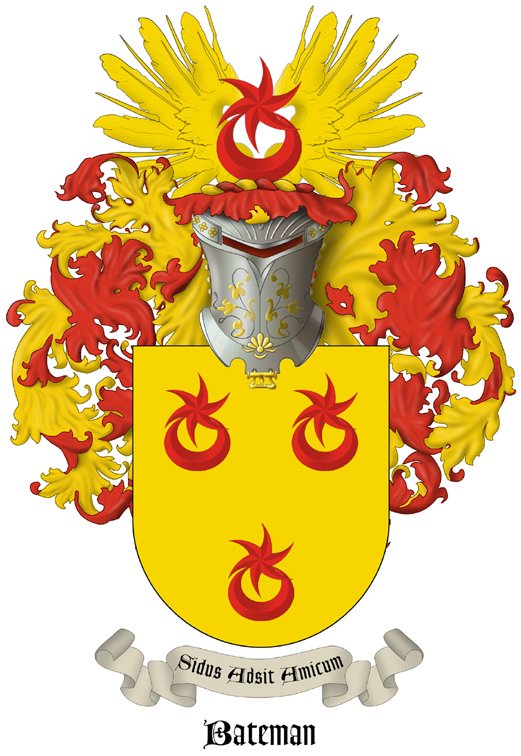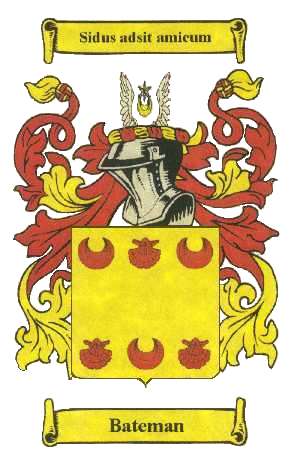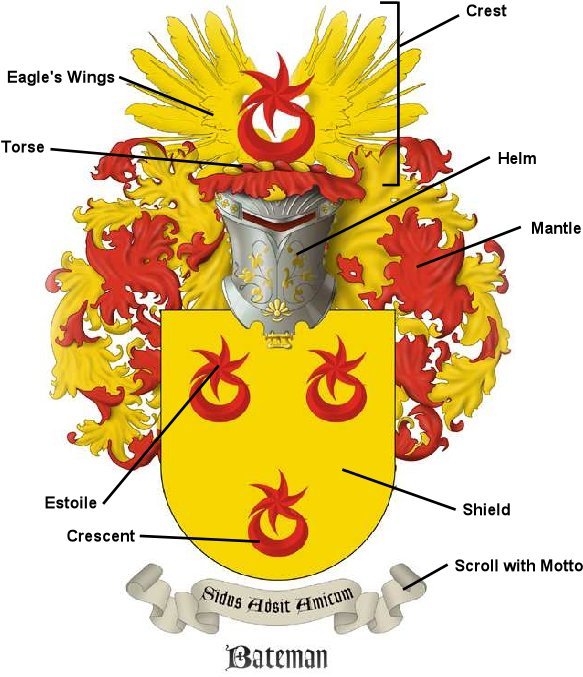A Short Essay on Heraldry and the Bateman Coat of Arms
|
by Russell Bateman
Heraldry deals with ancestral lines especially as they have implications for
lineage, titles, crests and coats of arms. Indeed, heraldry is complicated
enough that there actually exist professional heraldists. Except for a very
tiny number of official heraldists, the majority make a living by selling
heraldry services, such as researching family coats of arms for individuals,
schools, communities, etc. Herald, the term, comes from French,
héraut d’armes, a public officer whose function was to carry
messages, particularly of declaration of war, or to announce the arrival of
high persons such as the king. John the Baptist was, in effect and in
symbolism, the herald of Jesus Christ.
|
Record: 30533
Middleton by Youlgrave, Derby-
shire, England, descended from
William Bateman, of South
Winfield, living in 1298.
Arms: Or, three crescents,
each surmounted by an estoile
gules.
Crest: A crescent and estoile
as in the arms between two
eaglešs wings or.
Motto: Sidus adsit amicum (let
a friendly star be present).
|

|
Coats of arms are a delightful panache for family genealogists, a sort of icing
on the family cake. A family may gather together pedigrees, photos and
histories, but inevitably will seek some concise seal upon or banner over their
family history work. A coat of arms is a graphic representation that lends a
special cachet to a family’s work and so it is highly desirable to use
one on the cover of a book, family stationery, or the family webpage.
Disclaimer
I am a new-comer to this field. What I have written here is all I have been
able so far to learn in casual research over the last two or three years. If
you know something I don’t, please do not hesitate to share it with me,
Russell Bateman.
The Coat of Arms in History
We have to wonder what the history of the family coat of arms is. What
legitimacy does a coat have? How can it be determined what a family’s
coat is? What if there is more than one coat for a given name?
In some countries there are even laws, largely ignored as near as I can tell,
that insist that only the direct line of male heirs can use the coat of arms
granted to an ancestor. The United States of America has no such laws.
The ideas of liberty, equality and fraternity that have grown out of the
American, French and other revolutions make it unthinkable that any person or
family be undeserving of respect, dignity and the right to think of himself or
itself as special. This feeling is all the more acute on the part of the
individual for his own family.
Most Americans of European descent probably have a family name for which there
is already a coat of arms even if, strictly speaking, they have no official or
formal right to display that coat.
The coats of arms originated in the Middle Ages as a way of distinguishing
individual combattants, particularly wealthy knights, on the field of battle.
You had to be wealthy to be able to afford the necessary armor of a knight and
wealthier still to have it decorated and maintained in a distinctive way by
which others could recognize you—including others who knew your coat of
arms, but did not know you personally. There are tales according to which
combattants were mistaken in the field. William the Conqueror reportedly lifted
his helmet at one point in the battle of Hastings in order to rally his troups
among whom the rumor of his death had begun to spread.
Authentic or historic coats of arms contain a graphic representation of the
deeds or "gests" (an ancient French word for the deeds of a knight) of the
originating ancestor. As a knight became experienced (mostly, as he survived),
he gained recognition for acts of valor in the service
of his lord and that lord granted him honor, which honor might be reflected in
his coat of arms much as a military officer or soldier today receives ribbons
and medals to display upon his person for services rendered to his country.
Historic or official coats of arms and their elements are recorded in
long-established and reverenced documents such as Burke’s General
Armory and Reitstap’s Armorial General. These are are two of
the resources that heraldists use in researching a family’s coat of arms.
Sometimes coats of arms
already have surviving graphical representations, but most of the time, the
heraldist recreates the coat of arms from a description written in a strange
language mix of French, English and German terms. Reputable heraldists will
offer your coat of arms in some graphic medium after careful research including
interpreting the description of your authentic coat if extant.

The Coat of Arms in Our Day
What if my family has no coat or several coats? This the case of the Bateman
family. Why? I communicated to
David Humphreys,
a Welsh heraldist whose services I’ve used a couple of times before, the
coat that some of our family had been using (reproduced here on the right) and
he created a heraldic description from it. An authentic description is called a
"blazon" so named because when a knight appeared in a tourney, a blast was
given on trumpets and a herald named aloud and described the arms on the
knight’s shield and the surcoat worn over his armor.
The Bateman coat of arms is described in the following heraldic language:
|
| Record:
| 30533
|
|
| Name and origin:
| Middleton by Youlgrave, Derbyshire, England, descended from
William Bateman, of South Winfield, living in 1298.
|
|
| Arms:
| Or, three crescents, each surmounted by an estoile gules.
|
|
| Crest:
| A crescent and estoile as in the arms between two eagle’s wings
or.
|
|
| Motto:
| Sidus adsit amicum, let a friendly star be present
(sometimes: let a propitious star be present).
|
In English we would say, "A shield of gold with three crescents, each with a
red star atop. The crest consists of a torse supporting a crescent and star in
the arms of eagle’s wings." (or is French for gold; gules
means red.) Anything else is optional and left to the imagination or artistic
talent of the heraldist.
With the disappearance of warfare the way it was done on the medieval
battlefield, the coat of arms has long been a largely decorative phenomenon.
The Elements of a Coat of Arms
The coat of arms consists of the following elements (refer to the Bateman
coat of arms below):
- shield which displays the symbols or charges that signify the
knight;
- helm, different in style and position according to rank;
- crest, which in old times actually adorned (or may have) the
helmet for purposes of identification. Some coats of arms, often
instutional ones like municipalities, universities, businesses, do not
have a crest. The crest may include a crown;
- torse which consists of six bands of silk in alternating colors
from the shield and which hold the crest in place. The newer Bateman
crest is not affixed with a torse; the torse on the old one is
visible;
- motto, a war cry or family slogan. Not all coats of arms have
them. These have been lost or forgotten. Ours is Sidus adsit
amicus;
- mantling, which represents a garment attached to the helmet as a
protection against the elements is now shredded into a ragged, flowing
design that is become a backdrop for the shield and helmet;
- supporters, or animal or human figures, on either side of the
shield holding it up. Supporters are used more frequently on civic or
institutional coats of arms. Our coat has none of this.

The Bateman Coat of Arms
Let’s be frank. The depth of our coat of arms may or may not be that of
medieval landed gentry. While the origin of the coat we use now is not
entirely known, it is ours if we want to keep it. I chose the new one after
going back and forth with David Humphreys who offered me two different existing
Bateman coats, neither of which seems satisfactory because they didn’t
have the elements that the coat my grandfather Alfred Hess Bateman had on his
wall nor b) they didn’t jive with another coat I got, presumably of the
same heritage as my grandfather’s, which also displayed certain elements.
I sent him an indication as the to the desired elements and he created the new
one you see at the top of this page. Modern coats are whatever the family
decides to adopt. They serve as ornement and as a rallying symbol for the
family.
Let’s examine the elements of our coat of arms including their
significance.
Shield charge, ordinary and colors
What is upon the shield is known as "the charge," usually an animal, but
sometimes something else like a hand, arm, foot, sceptre, millstone, harp, etc.
The main charges upon our shield are three crescents which usually stand for an
ancestor having received honor by a sovereign. The six-pointed (wavy) star
indicates celestial goodness and nobility. Red (gules) is the color of
strong, but magnanimous military strength. Our older coat contained also
scallops (shells) indicative of travel to far away places.
Perhaps the Bateman coat of arms is as much a symbol to live up to as the
expression of ancestral laurels.


